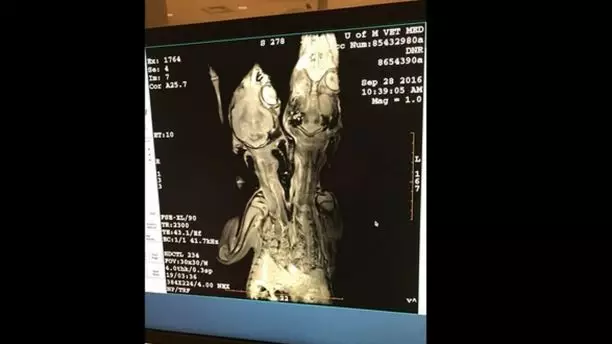
A man out hunting mushrooms accidentally discovered one of the strangest recent advancements in natural science after he came across a two-headed fawn.
The young deer were found stillborn in southeastern Minnesota in May 2016 and it has now been the centre of a major scientific discovery - the first conjoined two-headed deer to have been brought to full term.

"The bodies of the fawns were joined ventrally and laterally with two separate necks and heads," wrote Lou Cornicelli in an abstract in the American Midland Naturalist, a journal of zoology.
Advert
"This is the first case described of conjoined two-headed white-tailed deer brought to full-term gestation and delivered."
Cornicelli, who is a wildlife researcher for the Minnesota Department of Natural Resources (MDNR), told Fox News: "It's never been described before. There are a few reported cases of two-headed ungulate fetuses, but nothing delivered to term. So, the uniqueness made it special."
"Animals that are stillborn, they don't last long on the landscape because of scavengers," added Cornicelli. "In our case, we were lucky that he found the fawn before it was eaten and turned it into DNR."
Advert
The discovery was made by a mushroom hunter in May 2016 near the town of Freeburg, Minnesota.
After the hunter contacted the Minnesota DNR, the fawns were frozen before being taken for analysis. Tests uncovered that the creatures had separate heads and necks, which came together at the spine. The body also had two livers, spleens and gastrointestinal tracts.
"Their anatomy indicates the fawns would never have been viable," said Gina D'Angelo, one of the co-authors of the study and a researcher at the University of Georgia.
"Yet, they were found groomed and in a natural position, suggesting that the doe tried to care for them after delivery. The maternal instinct is very strong."

There were several severe internal faults that would have precluded the animals ever having any kind of lasting life. D'Angelo added that conjoined twins are common in some species - particularly cattle and sheep - but are seen less regularly in other animals such as deer.
Advert
The fawns have now been stuffed and will be put on display at the MDNR headquarters in St Paul, Minnesota.
"We all thought it was pretty neat and were glad to be able to show it to the public," said Lou Cornicelli, "The taxidermists, Robert Utne and Jessica Brooks did a great job with the mount and treated it very respectfully."
Featured Image Credit: Gino D’Angelo / University of GeorgiaTopics: deer, Interesting, US News, Animals